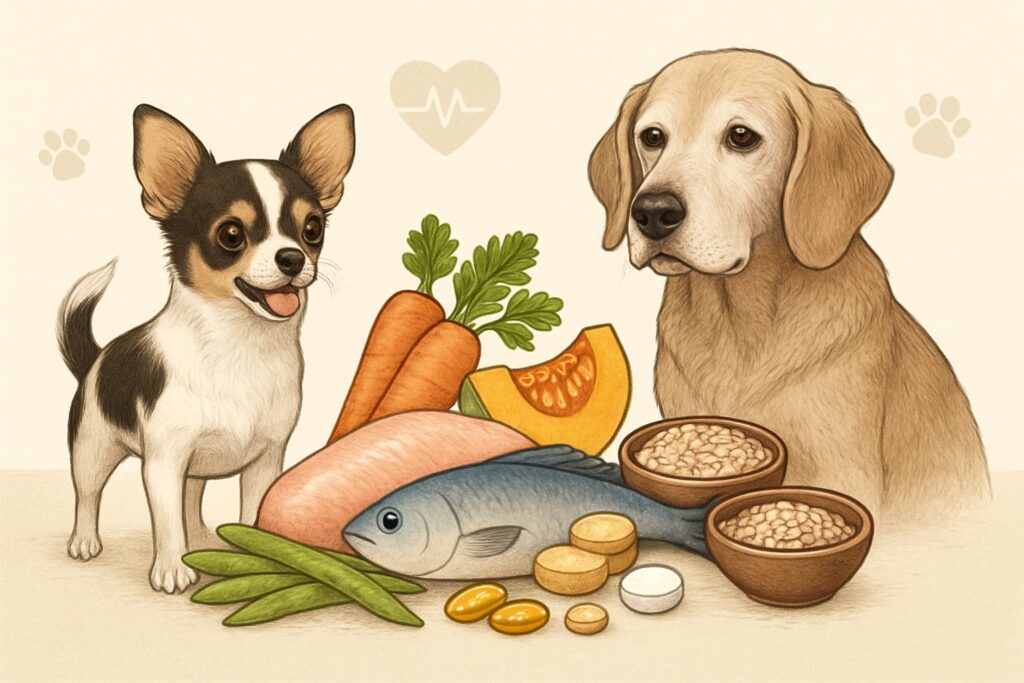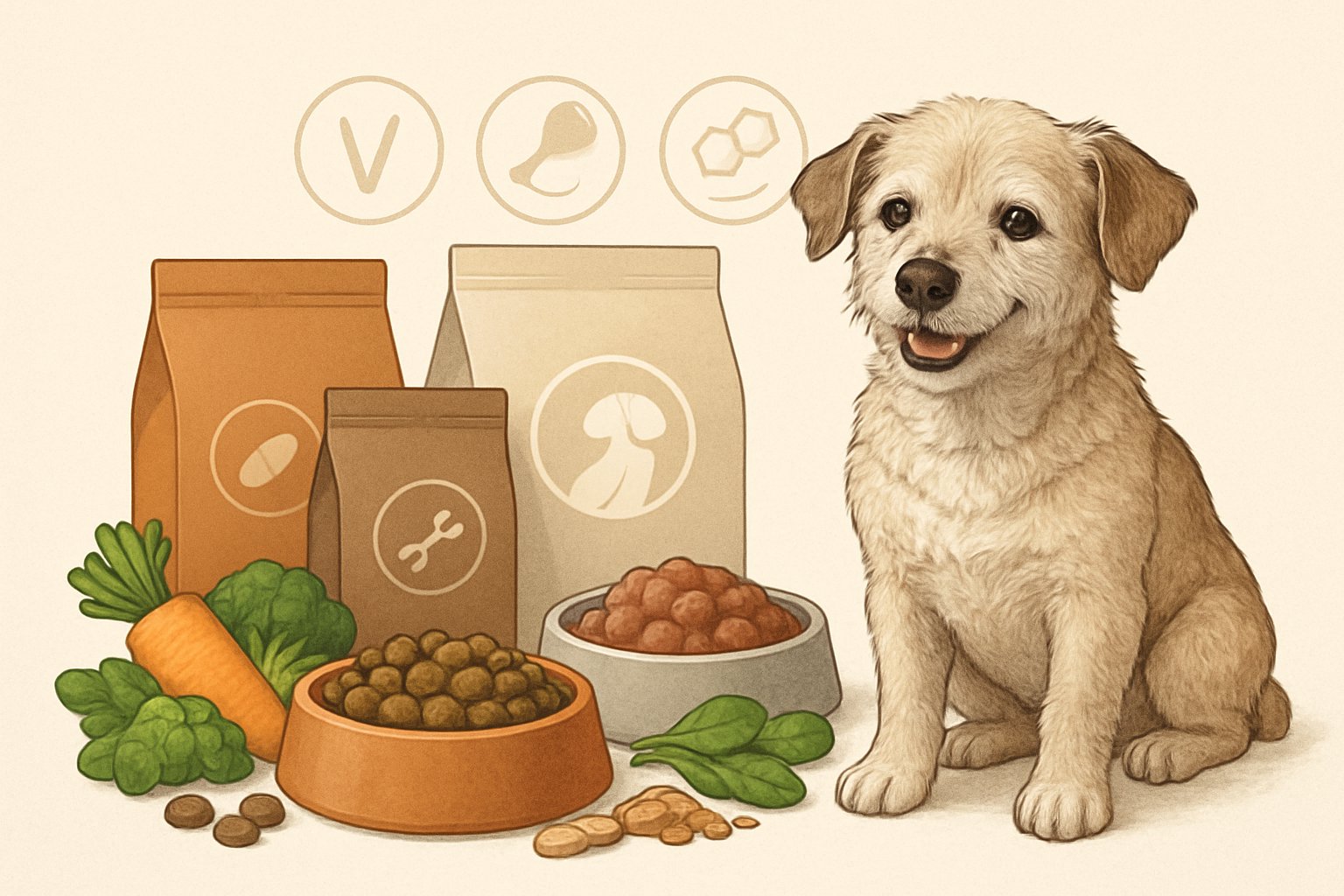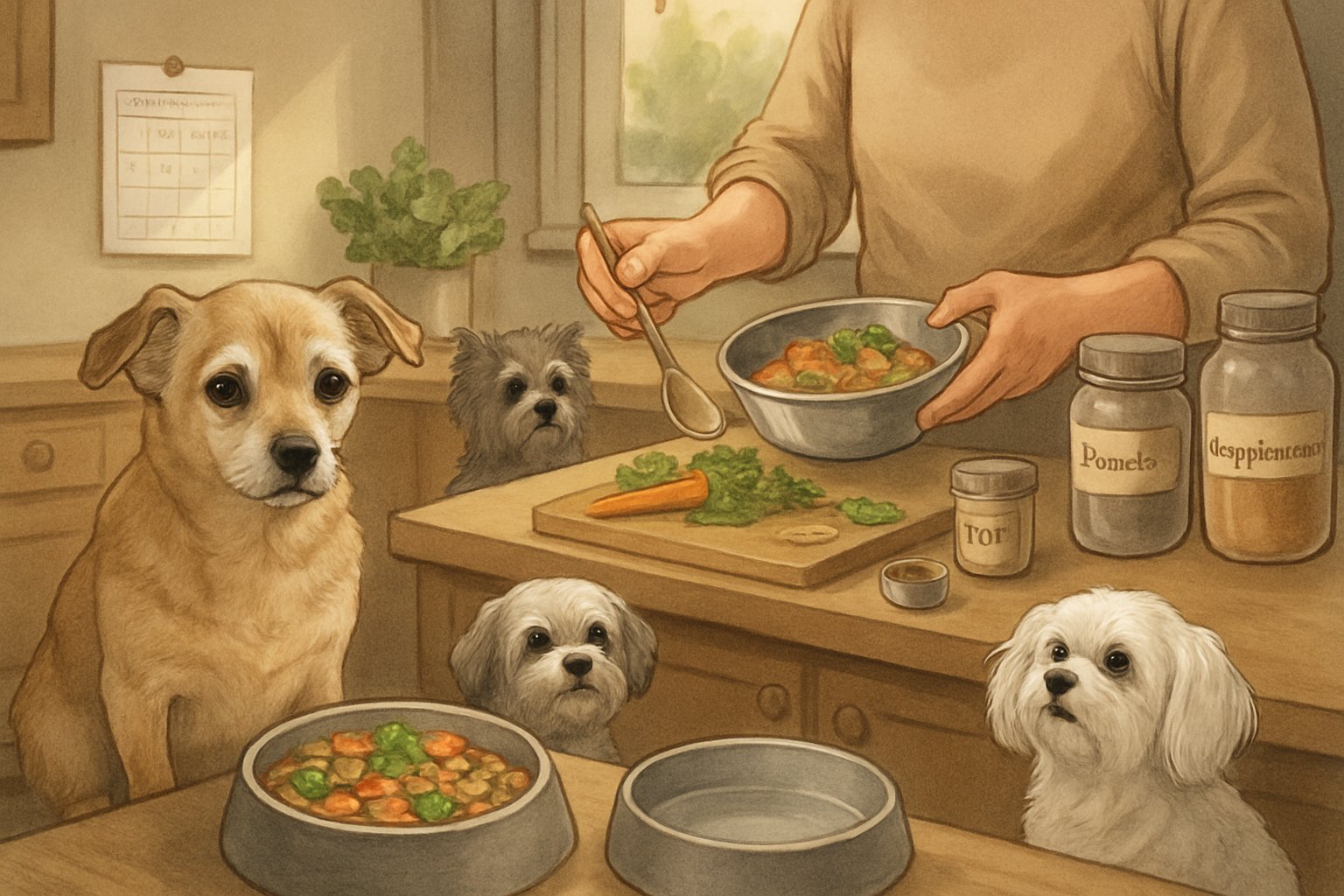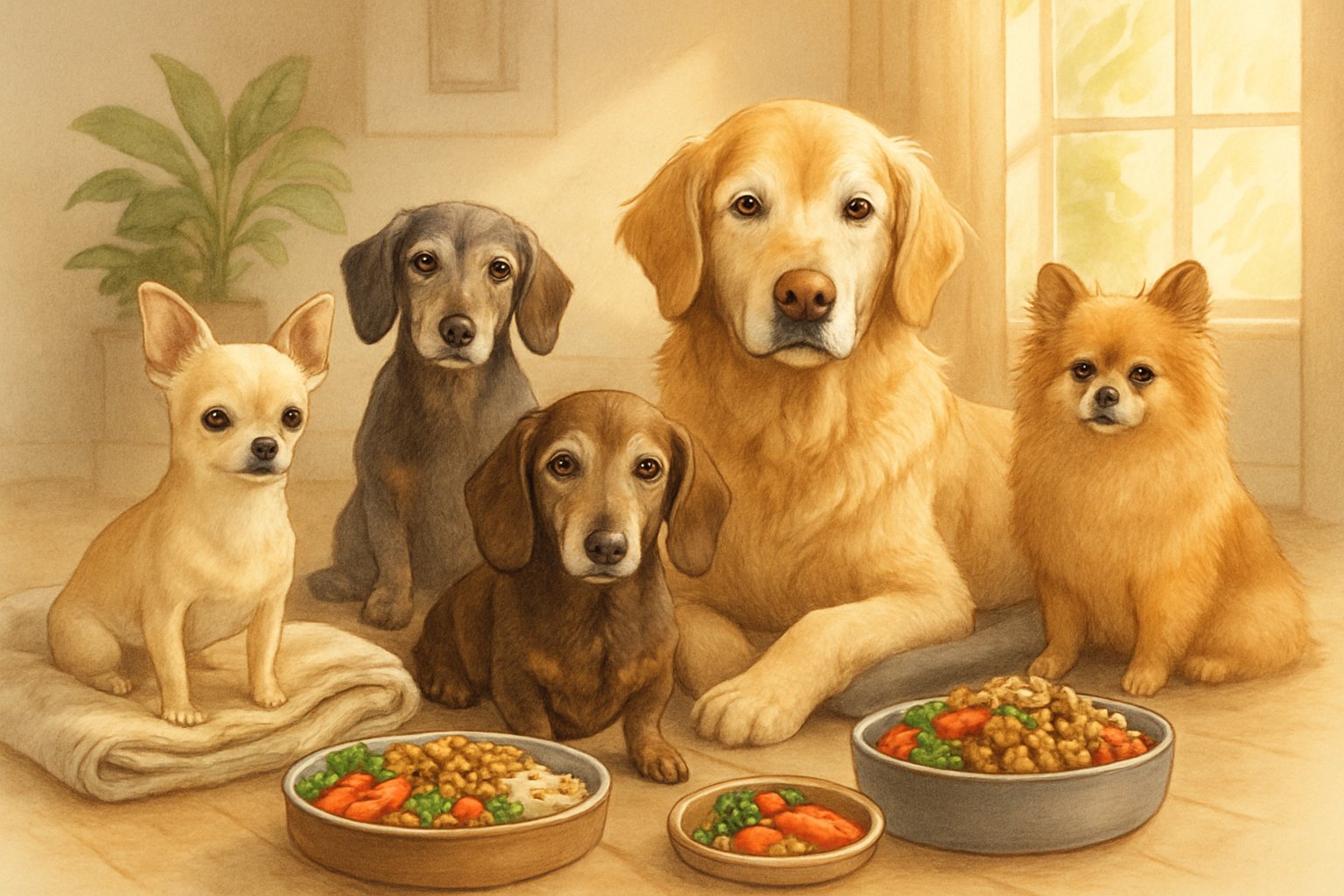Feeding your senior small dog the right nutrition can add years to their life and life to their years. Senior small dogs need fewer calories but more high-quality protein, joint-supporting nutrients, and easily digestible ingredients to thrive as they age.
I’ve seen too many pet parents struggle with their aging pups losing energy, gaining weight, or developing health issues that proper nutrition could have prevented.

Table of Contents
The thing is, small breed dogs are considered senior by age 7, which often catches owners off guard. Your once-spunky Chihuahua or Yorkie starts slowing down, and you wonder if it’s just normal aging or something you can actually help with.
The truth? What goes in their bowl makes a huge difference.
You’re about to discover exactly what nutrients your senior small dog needs most, how to choose the right food formula, and real-world feeding strategies that actually work.
I’ll walk you through everything from decoding ingredient labels to handling special health conditions, so you can give your furry friend their best golden years.
Complete Small and Senior Dog Nutrition Guide – Key Takeaways
- Senior small dogs need high-quality protein with fewer calories to maintain muscle while preventing weight gain
- Joint support nutrients and antioxidants become essential for aging dogs to maintain mobility and immune health
- Switching to smaller kibble and easily digestible ingredients helps senior small breeds absorb nutrients better
Cracking the Unique Needs of Senior and Small Dogs
Senior dogs face different challenges than younger pups, especially when they’re small breeds that age faster than larger dogs. Their bodies slow down, their metabolism changes, and what worked for years might suddenly cause problems.
Why Senior Dogs Need a Nutrition Rethink
Let’s be real — watching your dog hit their golden years hits different. I’ve seen too many pet parents stick with the same kibble they’ve used for years, not realizing their senior pup’s body is crying out for something different.
Your dog’s metabolism slows down significantly after age 7. What used to keep them energized now might pack on unwanted pounds.
Their kidneys work harder, their joints ache more, and their immune system needs extra support.
Here’s what changes in senior dogs:
- Protein needs increase to maintain muscle mass
- Fat content should decrease to prevent weight gain
- Fiber requirements go up for better digestion
- Antioxidants become critical for immune support
I always tell dog parents to think of it like this: you wouldn’t feed a marathon runner the same meal as someone recovering from surgery. Senior dogs require a balanced diet that meets their unique needs, and ignoring this leads to health problems down the road.
The biggest mistake? Waiting too long to make the switch.
Your 8-year-old Golden might still act like a puppy, but their organs are already working overtime.
How Small Breed Dogs Age Differently
Ever wonder why your Chihuahua seems to age faster than your neighbor’s Lab? Small breeds hit senior status earlier — around 7 years old — while large breeds don’t get there until 10 or 11.
Small dogs live longer but age differently. They burn calories faster, have higher metabolic rates, and need more calories per pound than big dogs.
This creates unique challenges as they get older.
Small senior dogs face these specific issues:
- Dental problems from tiny teeth and crowded mouths
- Hypoglycemia risk from skipping meals
- Joint stress from carrying proportionally more weight
- Temperature sensitivity that worsens with age
I’ve noticed small breeds also develop pickier eating habits as they age. That Yorkie who used to inhale anything? Now they turn their nose up at kibble that’s too big or too hard.
Super senior dogs beyond 16 years for small breeds need even more specialized care. Their nutritional needs become as specific as a prescription.
Spotting the Signs Your Dog Needs a Diet Change
You know your dog better than anyone. When something’s off, you feel it in your gut before the vet confirms it.
Watch for these telltale signs:
- Weight gain around the middle (even if they’re eating the same amount)
- Less enthusiasm at meal time or leaving food behind
- Drinking more water than usual
- Stiffer movements after lying down
- Dull coat that’s lost its shine
The tricky part? These changes happen gradually. Your dog doesn’t wake up one morning looking different.
I recommend taking photos every few months. It sounds silly, but side-by-side comparisons reveal changes you miss day-to-day.
Energy level shifts are huge red flags. If your usually peppy Pomeranian now naps through their favorite activities, their current food isn’t cutting it anymore.
Don’t wait for dramatic symptoms. Nutritional needs of senior dogs include joint support and immune system boosting that prevents problems rather than treating them after they start.
Essential Nutrients: What Matters Most for Aging Dogs
Your senior dog’s body works differently now, and their nutritional needs have shifted big time. Protein becomes crucial for maintaining muscle mass, omega fatty acids keep their brain sharp and coat glossy, while fiber helps their aging digestive system run smoothly.
The Protein Priority: Muscle, Strength, and Recovery
I’ve watched too many dog parents worry about giving their senior pup “too much” protein. Let me set the record straight — aging dogs actually need more high-quality protein, not less.
Here’s what happens as dogs age. Their bodies become less efficient at processing protein.
They start losing muscle mass faster than younger dogs.
Senior dogs need 25-32% protein in their diet, compared to 18% for adult dogs. This isn’t just about muscles either.
Protein supports:
- Immune system function
- Wound healing
- Brain health
- Organ maintenance
I always recommend looking for high-quality proteins like chicken, fish, or lamb as the first ingredient. Avoid generic “meat meals” or by-products.
Your dog’s kidneys can handle quality protein just fine. The myth about reducing protein for senior dogs comes from outdated thinking about kidney disease.
Fats, Omegas, and Keeping That Shine (and Brain!)
Ever notice how some senior dogs have dull, dry coats while others still look puppyish? The secret often lies in their fat intake.
Omega-3 fatty acids are game-changers for aging dogs. I’m talking about EPA and DHA from fish oil specifically.
These powerhouse nutrients:
- Reduce joint inflammation
- Support cognitive function
- Improve coat quality
- Boost heart health
Senior dogs need about 5-8% fat in their diet. Too little fat means dry skin and brain fog. Too much can lead to pancreatitis.
Fish oil supplements work wonders, but whole fish sources like salmon work even better. I’ve seen dogs with arthritis move easier after just weeks of proper omega-3 supplementation.
Pro tip: Look for fish oil with at least 300mg of combined EPA and DHA per 10 pounds of body weight.
Fibre, Digestion, and Avoiding Tummy Troubles
Let’s talk about something every senior dog owner faces—digestive issues. Your older pup’s gut just isn’t as tough as it used to be.
Fiber becomes your best friend here. But not all fiber works the same way.
Soluble fiber (think sweet potatoes, pumpkin) helps firm up loose stools. Insoluble fiber (from veggies, brown rice) keeps things moving along.
Senior dogs do well with 3-5% fiber in their diet. This helps prevent constipation and supports healthy gut bacteria.
- Maintain steady blood sugar
- Create feeling of fullness
I always keep canned pumpkin in the pantry. A tablespoon mixed into meals can work wonders for both diarrhea and constipation.
Prebiotics and probiotics deserve a shout-out too. These help the good bacteria in your dog’s gut, which becomes even more important as their immunity gets a bit shaky with age.
Choosing the Right Senior Dog Food Formula

When your furry companion hits their golden years, their senior dog food needs change a lot from their puppy days. The nutritional needs of senior dogs mean you have to pay attention to protein levels, ingredient quality, and food texture to help their aging bodies and minds.
Senior Dog Food vs. Adult Food: The Truth
Honestly, I used to think senior dog food was just a marketing gimmick. Then my 8-year-old Golden Retriever started slowing down, and I realized the difference between adult and senior formulas is real.
Senior dog food usually has 25-30% more protein than adult formulas. That might sound weird since older dogs move less, but here’s the thing: aging pups lose muscle faster and need that extra protein just to keep what they’ve got.
The fat content is a different story. Senior formulas tend to have 10-15% fat, while adult food sticks around 18-20%. That drop helps prevent weight gain as their metabolism slows.
Key differences I’ve noticed:
- Smaller kibble size for easier chewing
- Added glucosamine and chondroitin for joint support
- Higher fiber content for digestive health
- Antioxidants like vitamin E for immune support
Many senior dog foods are formulated by size, which matters more than you’d think. Small breeds become seniors around 7-10 years, but large breeds hit senior status as early as 5-6 years.
Ingredients to Seek (and Ingredients to Nix)
Ever wonder why some senior dogs thrive while others just seem to struggle? The ingredient list usually holds the answer.
What I always look for first:
| Must-Have Ingredients | Why They Matter |
|---|---|
| Named meat proteins (chicken, beef, salmon) | Maintains muscle mass |
| Glucosamine & chondroitin | Supports joint health |
| Omega-3 fatty acids | Reduces inflammation |
| Prebiotics & probiotics | Aids digestion |
The first ingredient should always be a specific meat source—not “meat meal” or “by-products.” I learned this the hard way when my friend’s senior Beagle had constant tummy troubles until switching to a food with real chicken listed first.
Red flags that make me put the bag back:
- Corn, wheat, or soy as main ingredients
- Artificial colors (Blue 2, Red 40)
- Generic stuff like “animal fat” or “meat meal”
- BHA, BHT, or ethoxyquin preservatives
Here’s something that surprised me: many veterinarians recommend specific senior dog foods for your dog’s health issues, not just their age. Joint problems? Look for foods with real therapeutic levels of joint-supporting nutrients.
Wet, Dry, or Homemade? Pros, Cons, and Surprises
This decision drove me nuts when my senior pup started having dental issues. Each option brings some surprises I never thought about before.
Dry kibble works when:
- Your dog has healthy teeth
- You’re watching your budget
- Portion control matters for weight
- Storage convenience is a plus
Wet food shines for:
- Dogs missing teeth or with dental pain
- Picky eaters who lost interest in food
- Seniors who don’t drink enough water (wet food is 70-80% moisture)
- Dogs with kidney issues who need more hydration
The biggest surprise? Mixing both often works best. I toss a spoonful of wet food into dry kibble, and suddenly my dog is way more interested in dinner.
Homemade senior dog food sounds tempting, but honestly, it’s risky without a vet’s help. Senior dogs need really specific nutrient ratios, and it’s tough to get that right at home. One study said 95% of homemade dog diets were missing something important.
If you’re set on homemade, work with a veterinary nutritionist. It might cost more than you expect, but it’s worth it to keep your aging buddy healthy.
My practical approach: I start with a high-quality commercial senior food, then add vet-approved extras like cooked sweet potato or green beans. It keeps things balanced and gives some variety.
Real-World Diet Strategies for Everyday Life

Getting your small or senior dog’s nutrition right isn’t just about picking the perfect food. It’s about making it work with your real, messy schedule.
Let me walk you through portion control tricks and gentle food transition methods that actually work—without making you lose your mind.
How Much and How Often? Portion and Schedule Hacks
Ever stared at your dog’s bowl, unsure if you’re feeding too much or too little? You’re definitely not alone. I get this question from worried pet parents all the time.
The Golden Rule: Your Dog’s Age Changes Everything
Senior dogs need about 20% fewer calories than younger adults. Their metabolism slows, and most aren’t as active. Small dogs burn calories faster, so they often need more frequent meals.
Here’s what works for me:
For Senior Dogs:
- Feed twice a day instead of once
- Cut portions by 15-20% from adult amounts
- Senior dog feeding schedules should allow for slower digestion
For Small Dogs (any age):
- 3-4 small meals keep blood sugar steady
- Use a kitchen scale—eyeballing doesn’t cut it with tiny portions
- A 5-pound dog needs way less than a 15-pound dog
My Favorite Hack: I use an ice cube tray to pre-portion wet food or treats. Freeze them, then pop out what you need. It’s easy portion control, no guesswork.
The Rib Test Run your hands along your dog’s ribs. You should feel them easily without pressing hard, but you shouldn’t see them sticking out. Honestly, this is better than any chart for figuring out if you’re feeding the right amount.
Switching Foods Without Drama (or Tummyaches)
Let’s be real — nobody wants to clean up a 2 AM stomach disaster because you changed foods too quickly. I’ve learned this lesson the hard way with my own dogs.
The 7-Day Transition That Actually Works
Most pet food bags say “gradually transition over 7-10 days,” but they never tell you exactly what that means. Here’s the method I’ve used that actually works:
- Days 1-2: 75% old food, 25% new food
- Days 3-4: 50% old food, 50% new food
- Days 5-6: 25% old food, 75% new food
- Day 7: 100% new food
For Senior Dogs: Go Slower
Older digestive systems need extra patience. I stretch this to 10-14 days for my senior dogs, especially when switching to senior dog food formulas.
Warning Signs to Watch For:
- Loose stools lasting more than 2 days
- Vomiting
- Loss of appetite
- Excessive gas (more than usual)
If you spot these signs, slow down the transition. Go back to a higher percentage of the old food and take it even slower.
Pro Tip: Add a tablespoon of plain pumpkin (not pie filling) to each meal during transitions. It’s gentle on stomachs and most dogs love the taste.
Emergency Backup Plan
Keep a small bag of your dog’s current food even after switching. If the new food doesn’t work out, you’ll want something familiar on hand while you figure out plan B.
Advanced Tips: Special Cases and Aging Well

Senior dogs face unique challenges as their bodies slow down and their nutritional needs shift. I’ve seen too many pet parents get frustrated when their once-eager eater suddenly turns picky or when joint stiffness makes mealtime uncomfortable.
Tackling Weight Changes and Loss of Appetite
Ever watched your senior pup push food around their bowl like they’re solving a puzzle? Loss of appetite hits hard when you’re already worried about your aging companion.
Weight loss in senior dogs often comes from decreased smell and taste sensitivity. I usually warm wet food just a bit to boost the aroma. Steam perks up kibble, too.
Appetite stimulants include:
- Adding bone broth to dry food
- Mixing in small amounts of cooked chicken
- Using puzzle feeders to spark interest
Some seniors gain weight from moving less. Portion control gets really important here.
Split daily food into 3-4 smaller meals instead of two big ones. That seems to work better for most older dogs.
Check your dog’s body condition weekly. Run your hands along their ribs — you should feel them easily, but not see them sticking out.
Digestible proteins help maintain muscle mass as metabolism slows. Look for foods with ingredients like fish, eggs, or hydrolyzed proteins.
Joint, Kidney, and Dental Friendliness
Stiff joints make reaching food bowls tough. Elevated feeders reduce neck strain and make eating easier again.
Joint support through nutrition includes:
- Omega-3 fatty acids from fish oil
- Glucosamine and chondroitin supplements
- Anti-inflammatory ingredients like turmeric
Kidney function naturally declines with age. Kidney-friendly diets have moderate protein and less phosphorus. Keep fresh water available at all times.
I’ve noticed a lot of senior dogs develop dental issues that affect eating. Soft foods or kibble soaked in warm water help dogs with tooth pain.
Dental-friendly options:
- Wet food formulations
- Softened kibble
- Raw or lightly cooked vegetables
Kidney health indicators include increased water consumption and frequent urination. Call your vet if you see these signs.
Joint supplements work best when you start early. Don’t wait until your dog can barely get up.
Vet Partnerships: When and How to Adjust Again
Your vet becomes your best ally in senior dog nutrition planning. I recommend bi-annual wellness checks for dogs over seven, not just once a year.
Blood work reveals hidden issues that affect nutrition needs. Kidney values, liver function, and thyroid levels all play a role in diet choices.
Schedule nutrition reviews when you notice:
- Appetite changes lasting more than 3 days
- Weight fluctuations of 5% or more
- Digestive upset becoming frequent
- Energy level drops significantly
Gradual transitions matter even more for seniors. Take 10-14 days to switch foods completely. Their digestive systems just don’t bounce back as fast.
Work with your vet to create feeding schedules around meds. Some meds need food, others work better on an empty stomach.
Supplement timing affects absorption. Separate calcium and iron supplements by at least 2 hours for best results.
Write down changes in eating, energy, and bathroom habits. This helps your vet give better advice at each visit.
Frequently Asked Questions
These common questions from small and senior dog parents cover everything from picky eaters to portion sizes. I’ll walk you through real solutions that work when your furry friend needs extra care.
At what age should I switch my small dog to senior food?
Most small-breed dogs should transition around 7 years old, but watch for signs like decreased energy, weight gain, or joint stiffness rather than relying solely on age.
Do senior small dogs need more or less protein than younger dogs?
Senior dogs actually need more high-quality, easily digestible protein (like chicken or fish) to maintain muscle mass as they age.
How often should I feed my senior small dog?
Feed 2–3 smaller meals per day instead of one large meal to prevent low blood sugar and aid digestion.
What’s the biggest difference between senior food and regular adult food?
Senior foods have fewer calories, more fiber, and added joint support (like glucosamine and omega-3s) to match slower metabolisms and aging needs.
My senior dog won’t eat—what can I do?
Try soaking kibble in warm water or broth, adding plain Greek yogurt or freeze-dried liver, or slightly warming the food to enhance aroma and appeal.
How much protein should my 10-year-old dog eat daily?
Senior dogs need about 25–32% protein in their diet, or roughly 2–3 grams per pound of body weight each day.
Can I give my senior dog the same food as my younger dog?
It’s not ideal—senior dogs need different nutrient ratios, including more protein, fiber, and omega fatty acids for joint and digestive health.
What’s the 80/20 feeding rule for dogs?
Feed 80% high-quality commercial food and 20% fresh, dog-safe foods like carrots, blueberries, or cooked chicken—adjusting calories to avoid weight gain.
How can I help my senior dog gain weight safely?
Use calorie-dense foods (15–18% fat), add healthy oils like fish or coconut oil, and feed 3 smaller meals a day to increase intake gradually.
How do I know if my senior dog needs more fiber?
Watch for constipation, straining, or irregular stools—signs your dog may need moderate fiber from sources like sweet potato or pumpkin.



Leave a Reply